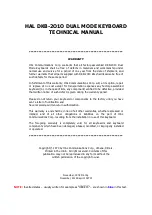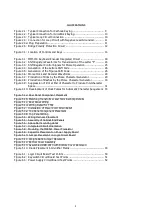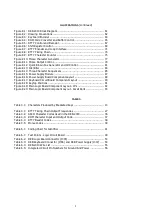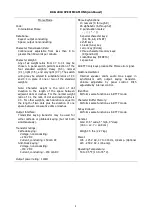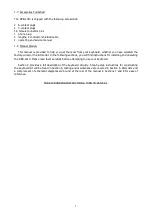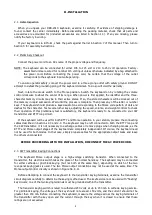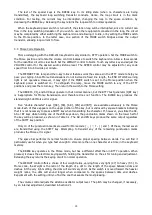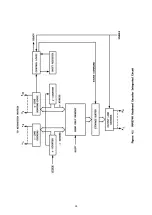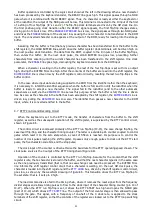
6
I. GENERAL INFORMATION
1.1 Description
The HAL DKB-2010 is a solid-state, electronic keyboard designed for transmitting both RTTY (Baudot)
and Morse codes. A successor to HAL Communication's popular first-generation keyboards, the DKB-2010
provides many advanced operating features:
1. A three-character buffer memory stores the characters typed for transmission at a constant rate.
Coupled with the n-key rollover capability, it helps iron out variations in typing speed and style.
2. A station identifier, included as standard equipment, automatically transmits the station call sign at the
touch of a key.
3. The four RTTY operating speeds (60, 66, 75, and 100 words per minute) are switch selectable and, to
assure stability, crystal controlled. The Morse speed is continuously variable from 8 to 60 words per
minute.
4. A warning light and tone signal the RTTY operator when line length exceeds 64 characters.
5. A built-in RTTY test generator automatically transmits a standard test message ("THE QUICK BROWN
FOX JUMPS OVER THE LAZY DOG'S BACK Ø123456789") at a single keystroke.
6. The Morse code weight can be set to any of four ratios by a frontpanel switch. Weight is unaffected by
changes in speed.
7. The space bar functions in the Morse mode to simplify interword spacing.
8. Two "memory" keys can be preprogrammed to automatically transmit three-letter combinations. One is
normally used to transmit "CQ", followed by a space. The code for the other (the AUX key) is selected
by the owner at the time of purchase; if not specified it is coded to transmit "DX" followed by a space.
For the RTTY operator, the DKB-2010 provides automatic transmission of the case-shift code when
typing numbers and letters; the shift key is needed only for certain punctuation marks. The loop switching
transistor in the keyboard output stage is completely isolated from chassis and ground so that it may be
connected at any convenient point in the station loop circuit.
For Morse operation, a sidetone oscillator with adjustable pitch and volume simplifies monitoring of the
transmitted code. Five double-character keys (SK, AS, AR, KN, and BT), along with an error key (which
transmits eight dots), provide the special characters needed in Morse work. A tune key overrides the
keyboard output and keys the transmitter on for adjustment. Keying is accomplished by a high-voltage
switching transistor, which may be connected for either cathode or grid-block keying.
The keyboard circuitry is constructed on three G-10 glass-epoxy circuit boards, housed in an attractive
yet rugged two-tone gray cabinet. The circuit boards are interconnected by a factory-prepared wiring
harness to simplify construction and servicing. Output connections are conveniently located on the rear
panel. The internal power supply incorporates active, series-pass regulators to ensure stability.
1.2 Instrument Identification
Your keyboard is identified by a serial number tag on the rear panel. It is suggested that you record it in
the space provided on the title page of this manual. Please refer to the serial number when contacting the
factory for information or service.
Summary of Contents for DKB-2010
Page 1: ......
Page 20: ...18...
Page 39: ...37 Table 4 3 ROM Converter Input and Output Codes...
Page 52: ...50 Figure 6 1 Logic Circuit Board Test Points...
Page 53: ...51 Figure 6 2 Keyswitch Circuit Board Test Points...
Page 54: ...52 Figure 6 3 Power Supply Circuit Board Test Points...
Page 57: ...55 Table 6 4 DKB 2010 Wire List...
Page 63: ...61...
Page 64: ...62...
Page 65: ...63...
Page 67: ...65...
Page 69: ...67...
Page 71: ...69...
Page 73: ...71...
Page 75: ...73...
Page 77: ...75...
Page 79: ...77...
Page 81: ...79...
Page 83: ...81...
Page 85: ...83...
Page 87: ...85...
Page 89: ...87...
Page 91: ...89...
Page 92: ...90...
Page 93: ...91...
Page 94: ...92...
Page 95: ...93...
Page 96: ...A1 EXTENDED MEMORY OPTION FOR THE DKB 2010 KEYBOARD INSTRUCTION MANUAL...
Page 100: ...A5...
Page 101: ...A6...


